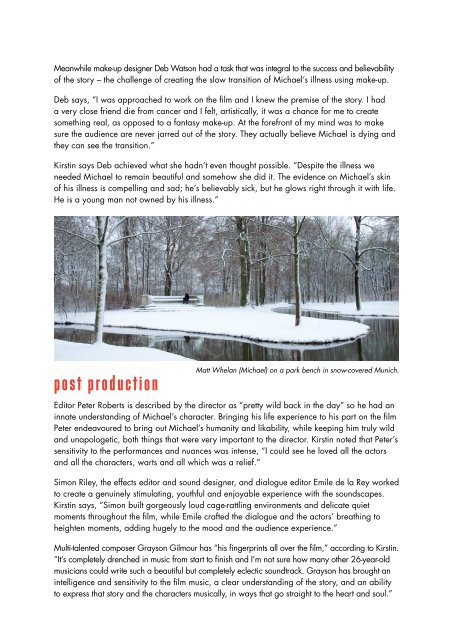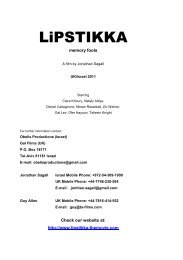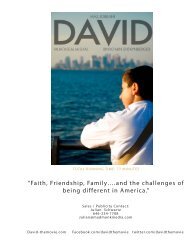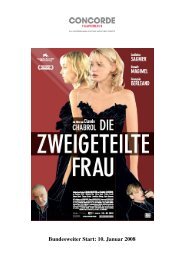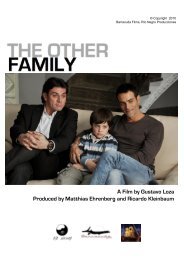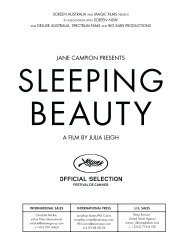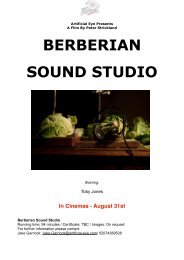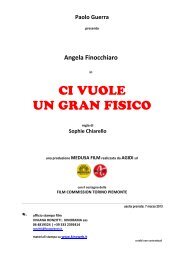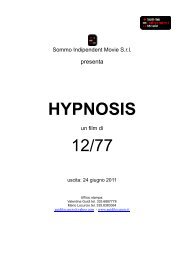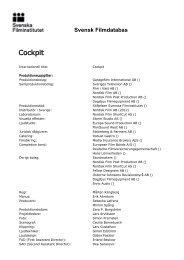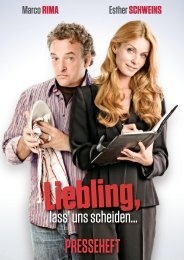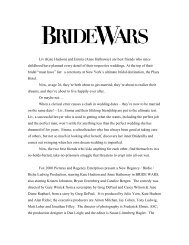the most fun you can have dying - FDb.cz
the most fun you can have dying - FDb.cz
the most fun you can have dying - FDb.cz
Create successful ePaper yourself
Turn your PDF publications into a flip-book with our unique Google optimized e-Paper software.
Meanwhile make-up designer Deb Watson had a task that was integral to <strong>the</strong> success and believability<br />
of <strong>the</strong> story – <strong>the</strong> challenge of creating <strong>the</strong> slow transition of Michael’s illness using make-up.<br />
Deb says, “I was approached to work on <strong>the</strong> film and I knew <strong>the</strong> premise of <strong>the</strong> story. I had<br />
a very close friend die from <strong>can</strong>cer and I felt, artistically, it was a chance for me to create<br />
something real, as opposed to a fantasy make-up. At <strong>the</strong> forefront of my mind was to make<br />
sure <strong>the</strong> audience are never jarred out of <strong>the</strong> story. They actually believe Michael is <strong>dying</strong> and<br />
<strong>the</strong>y <strong>can</strong> see <strong>the</strong> transition.”<br />
Kirstin says Deb achieved what she hadn’t even thought possible. “Despite <strong>the</strong> illness we<br />
needed Michael to remain beautiful and somehow she did it. The evidence on Michael’s skin<br />
of his illness is compelling and sad; he’s believably sick, but he glows right through it with life.<br />
He is a <strong>you</strong>ng man not owned by his illness.”<br />
post production<br />
Matt Whelan (Michael) on a park bench in snow-covered Munich.<br />
Editor Peter Roberts is described by <strong>the</strong> director as “pretty wild back in <strong>the</strong> day” so he had an<br />
innate understanding of Michael’s character. Bringing his life experience to his part on <strong>the</strong> film<br />
Peter endeavoured to bring out Michael’s humanity and likability, while keeping him truly wild<br />
and unapologetic, both things that were very important to <strong>the</strong> director. Kirstin noted that Peter’s<br />
sensitivity to <strong>the</strong> performances and nuances was intense, “I could see he loved all <strong>the</strong> actors<br />
and all <strong>the</strong> characters, warts and all which was a relief.”<br />
Simon Riley, <strong>the</strong> effects editor and sound designer, and dialogue editor Emile de la Rey worked<br />
to create a genuinely stimulating, <strong>you</strong>thful and enjoyable experience with <strong>the</strong> soundscapes.<br />
Kirstin says, “Simon built gorgeously loud cage-rattling environments and delicate quiet<br />
moments throughout <strong>the</strong> film, while Emile crafted <strong>the</strong> dialogue and <strong>the</strong> actors’ breathing to<br />
heighten moments, adding hugely to <strong>the</strong> mood and <strong>the</strong> audience experience.”<br />
Multi-talented composer Grayson Gilmour has “his fingerprints all over <strong>the</strong> film,” according to Kirstin.<br />
“It’s completely drenched in music from start to finish and I’m not sure how many o<strong>the</strong>r 26-year-old<br />
musicians could write such a beautiful but completely eclectic soundtrack. Grayson has brought an<br />
intelligence and sensitivity to <strong>the</strong> film music, a clear understanding of <strong>the</strong> story, and an ability<br />
to express that story and <strong>the</strong> characters musically, in ways that go straight to <strong>the</strong> heart and soul.”


